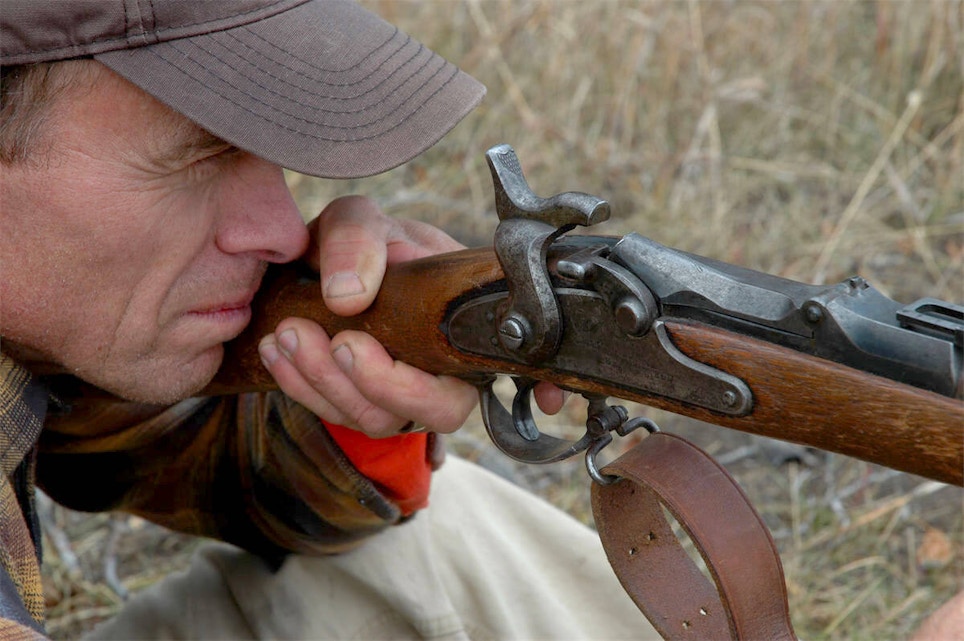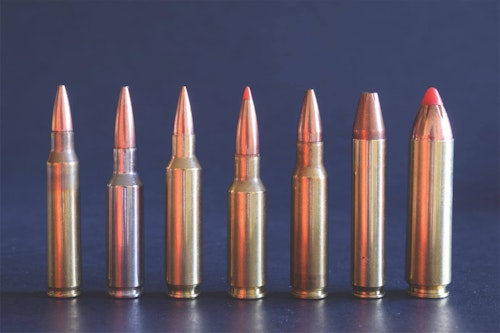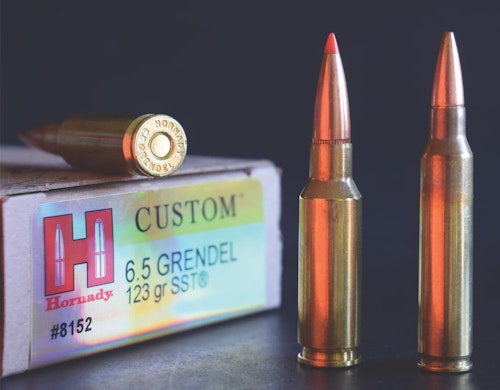Had you been hunting with a combat cartridge in the wake of George Custer’s last battle, it would have been the .45-70 Govt.
The U.S. Army’s first metallic cartridge, it arrived in the “trapdoor” Springfield rifle of 1873, so-called because its hinged breech lifted for loading, like a trap door. Given their ubiquity in the frontier West, cartridge and rifle figured heavily in its transformation. They brought native tribes to heel and nearly exterminated the bison. William F. Cody preferred his Springfield to early repeating rifles, naming it Lucretia Borgia, after the Spanish-Italian noblewoman immortalized as a femme fatale in a Victor Hugo play and Italian opera.
The 1873 Springfield gave way in 1892 to the Krag-Jorgensen bolt rifle, the Army’s first repeater and first to fire a smokeless round. Hurling 220-grain bullets at 2,200 fps (and, later, 180-grain soft points at 2,470), the “smallbore” .30-40 Krag shot much flatter than the .45-70 Govt., with its 405-grain slugs moving at 1,300 fps.
But this beautiful Norwegian-invented, American-modified rifle was costly to make. Besides, the .30-40’s rimmed case and blunt service bullet were 19th century holdovers. A decade later, the Army took up with the 1903 Springfield and a more powerful rimless cartridge, soon to be tweaked and labeled the .30-06 Springfield. First with 150-grain spitzer bullets that matched German developments, the .30-06 would remain the primary infantry round for U.S. armed forces through WWII. In 1939, after a 173-grain load extended its reach, the Army adopted a 152-grain bullet at 2,805 fps. The new Garand gas-driven rifle preferred it.
After the Garand brought the Allies victory in Europe and the Pacific, ordnance officers sought a shorter round for autoloading mechanisms. The T-65 was essentially a .30-06 with a shorter case. In 1952, Winchester snared it as the .308 Win. Two years later, the Army followed suit. It became the 7.62x51mm NATO in 1957. Its debut in the M14 rifle, then in military arms abroad, sealed its success. Eventually it would appear in more sporting rifles than any other centerfire round. The .308 Win. case holds 20% less powder than a .30-06 Sprg., but at 2,820 fps, its 150-grain bullets come within 100 fps of ’06 velocities.
Smaller Projectiles
In the 1940s the Army began looking for smaller, lightweight combat rounds to feed hungry, full-automatic arms on the horizon. In 1957, the .223 arrived as an experimental cartridge for the new AR-15 rifle, developed by Eugene Stoner of Armalite. Its 55-grain bullet at 3,250 fps met the Army’s spec of supersonic flight to 500 yards. Adopted in 1964 as the 5.56mm Ball Cartridge, M193, it earned NATO approval in 1980. A 62-grain, FN-designed SS109 boattail at 3,100 fps brought fast 1-in-7 rifling. The 5.56x45mm NAT0 and .223, identical in form, share the .378 head of their .222 Remington forebear, circa 1950. But they’re a tad longer, with a shorter neck. Powder capacity is 20% greater.
Factory-loaded with all types of bullets, 36 to 80 grains, the .223 Rem. is as versatile a small-bore as you’ll find. Velocities from 2,800 to 4,000 fps give it flat arcs for long shots and the energy to kill 150-pound animals. Service “hardball” ammunition is a cheap alternative to game loads. The .223 Rem. recoils gently. Bullets and rifle barrels have been refined over six decades to deliver fine accuracy.
But there are alternatives, all worthy reasons to buy another rifle. Most are of commercial origin. Wildcatters who, with youthful optimism, dream of million-round military contracts, count a few finalists.
The 7.62x39mm is a bona fide contender, if only for its ubiquity. Designed by Soviet engineers after a new German “machine carbine” was seized near Cholm in 1942, it is similar to that carbine’s cartridge, the 7.9x33mm Kurz. WWI had called into question the utility of cartridges with more than a 300-yard reach, as few soldiers could use them effectively that far. The Kurz was designed for a short, selective-fire weapon. Hitler would call it an assault rifle, reportedly to boost morale. The Soviets concluded too that a compact, lightweight cartridge with mild recoil to permit controlled full-auto fire would best equip soldiers clearing buildings and trenches.
The 7.62x39mm was initially chambered in SKS rifles, later in the AK-47 Mikhail Kalashnikov designed for it. A 123-grain FMJ bullet is loaded to 2,250 fps; so too expanding bullets of that weight. Bullet diameter has been listed variously as .310 to .312, usually .311, per the .303 British. Most .30s stateside use .308 bullets. CZ and Howa turn-bolt sporting rifles have barreled for the 7.62x39mm.
The .30 Carbine also dates to the early ’40s. With a round-nose bullet that exits at under Mach 2 and slips below Mach 1 shy of 300 yards — with a 200-yard zero it falls 30 inches — it’s no ballistic champ. But neither is it as destructive as hot .22s and 6mms. In many situations, 150 yards is plenty of reach, and the M1 Carbine’s iron sights limit most of us to shorter pokes.
This little rifle is the cartridge’s best advocate. As Nazi tanks rolled into eastern Europe, the U.S. government took bids for a 5-pound carbine to serve non-infantry personnel. In up-close combat, soldiers were abysmally inaccurate with pistols. A carbine would also have more punch and capacity. A Carolina moonshiner named David Marshall Williams, in minimum-security detention, built a model with a short-stroke gas mechanism. It was so easy to produce, Winchester is said to have submitted a prototype two weeks after winning the contract.
Within the month, Japan attacked Pearl Harbor. During the war, 10 U.S. companies built 6.5 million M1 Carbines for $45 apiece. They had 15-shot magazines and flip-over aperture sights for 100- and 300-yard zeros. In my youth the DCM peddled these gems to civilians for about $20. I should have snared one. Commercial renditions by Inland Mfg. and Auto Ordnance now cost more than $1,000. There’s no better truck gun. Handloaders: Mind case length. The .30 Carbine headspaces on the mouth.
AR-15 Options
Cartridges designed for the AR-15, with an eye to military contracts, include the 6.5 Grendel, 6.8 Remington SPC, .300 AAC Blackout and .458 SOCOM. The 6.5 Grendel, a necked-down 7.62x39mm, dates to 2003. Its 123-grain bullet at 2,850 fps flies very nearly as flat as a 75-grain .223 but brings a whopping 1,000 ft./lbs. of energy to 400 yards, 400 ft./lbs. more than the .223. Hornady loads ammo. The 6.5 Grendel is an exceedingly efficient round that with proper bullets can handily drop game as big as black bears.
The 6.8 Remington SPC (Special Purpose Cartridge), also a 2003 development, was designed for the AR-15 by SOCOM (the Army’s Special Operations Command). Based on the .30 Remington case of 1906, it has a .422 rim. Black Hills Ammunition loaded the first cartridges; Remington followed and in 2005 added the SPC to its commercial roster. A 115-grain .277 bullet at 2,625 fps carries 37% more energy than the 5.56x45mm M885A1 military load. In my Remington 700 it delivers fine accuracy.
Developed by Robert Silvers for Advanced Armament Corp., the .300 AAC Blackout drives 110-grain bullets at 2,375 fps, 208- and 220-grain bullets at a subsonic 1,020 fps. Midweight (135-grain) hunting bullets exit 16-inch barrels at 2,100 fps. With supersonic loads, this cartridge trumps the 7.62x39mm. It fits M16 magazines and actions and in subsonic form easily upstages the .45 ACP. Caveat: Given its short 1.308-inch case, a .300 AAC round may chamber in a .223/5.56mm rifle. Firing will destroy the rifle — and worse!
Despite its name, the .458 SOCOM has not at this writing been adopted by U.S. military forces. Marty ter Weeme designed it in the 1990s for M16 rifles. Bullets and ballistics suit close-range combat and suppressed barrels. Its 250- and 300-grain soft points at 2,000 and 1,900 fps carry 2,900 and 2,400 ft./lbs. out the muzzle; 600-grain bullets from subsonic loads exit at 950 fps. The fat bottle-neck case is .185-inch shorter than the .223s. It uses Large Rifle primers and has a rebated rim to fit standard (.473) bolt faces.
From Combat to Commercial
Combat rounds have formidable competition in commercial cartridges fashioned for the AR-15. The .22 Nosler and .224 Valkyrie, the 6.5mm ARC and .30 Remington AR come to mind — also wildcats such as the .257 Bartz. It’s not always necessary to endure the noise, recoil and expense of loads fashioned for bolt rifles at the close of the 19th century.
Long, pointed .22- to .30-bore bullets from compact cases and fast-twist rifling reach farther than violent loads of yesteryear. AR-15s and AK-47s, with svelte, short-action bolt rifles are all you’ll need for predators, foxes to black bears. Bullet choice and placement matter. But then, they always have.








